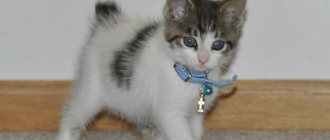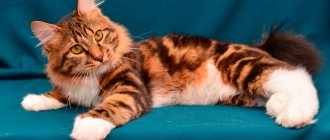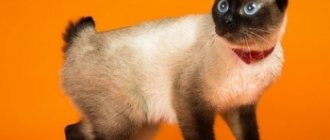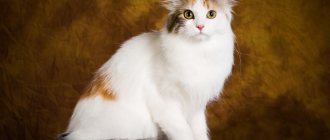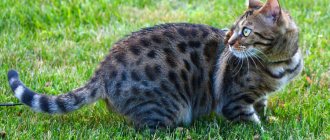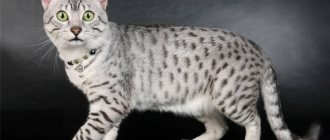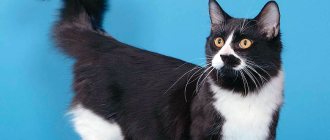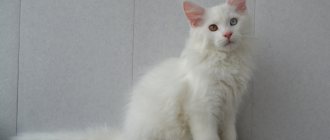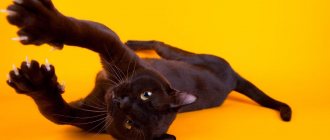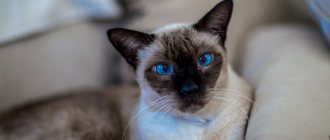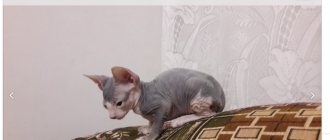Origin story
The distant ancestors of the American Bobtail lived in North America for many years.
But the peak of popularity and the formation of the breed as such occurred relatively recently - in the 60s. It was in those years that the Sanders couple, walking through the Indian reservation in Southern Arizona, came across a desperately meowing ball. They took the baby with them. Short-tailed, chocolate tabby-colored baby Yodi was transported to Iowa, and when he grew older, he was introduced to a neighbor's Siamese cat. The owners were pleased and surprised by the first litter - one of the kittens had exactly the same short tail as a bunny’s, cockily curved upward.
The first attempts at breeding were unsuccessful: the Sanders had no experience and did not know the genetic rules, so they tried to breed cats with each other in order to prevent the offspring from degenerating. The result was completely opposite: severe developmental defects led to deformities and death of bobtails at a young age.
Over time, breeders learned about the babies - this is what saved the breed from destruction. They immediately abandoned further attempts to breed a pure breed and began to infuse new blood, bringing bobtails together with Siamese, Burmese, Himalayan and even outbred (but healthy and strong) individuals. The standard for bobtails was developed in 1970, and they received official recognition in 1989 (TICA).
However, to this day, the true American Bobtail is a small breed. According to data, at the beginning of the 21st century there were only 216 females in North America, and even fewer males.
Short-tailed bobtails are often compared to Japanese ones, however, while Japanese cats have a short tail due to a recessive mutation, American cats have a short tail due to a dominant mutation. There are several versions of why this happened. According to one, the ancestors of the American bobtail were Manx, and according to another (this version was voiced to the Sanders by one of the Indians) - Yodi’s father was a real lynx!
How to choose the right kitten
Pedigree kittens are sold only in specialized nurseries in North America. When choosing, it is important to make sure that the little Yankee Bob has an international veterinary passport with vaccination marks and a metric confirming his origin. You definitely need to pay attention to the conditions in which the children are kept and their appearance.
A purebred kitten must have:
- short flexible tail, without creases or large knots;
- soft, shiny and elastic wool;
- straight back;
- tassels on the ears;
- long hind limbs.
The health of a small bobtail can be judged by its soft belly, clear eyes, clean coat and lack of scratching.
Kitten care
Conscientious Yankee Bob breeders do not transfer kittens to new owners before they are 3 months old. By this age, short-tailed bobtails have time to grow a little, get stronger and become more independent.
Before taking a kitten to a new home, they buy a “dowry” for it. A small bobtail will need:
- bed or house;
- carrying bag;
- bowls for food and water;
- tray and filler;
- toys;
- hygiene products;
- scratching post
Important. At first, the small American Bobtail is fed what the breeder gave it. New foods are introduced into the diet of a short-tailed kitten gradually, making sure that they do not cause allergies or digestive disorders.
Standards
Individuals of this breed can hardly be called miniature: while females weigh on average 4-6 (rarely 7 kg), then males gain 8 or even 10 kg.
| Standard | Name |
| Head | Wedge-shaped, with rounded features, proportional to the body. The muzzle is wide, with full, round cheeks and plump whisker pads. |
| Ears | Large or medium in size, with rounded tips, a wide base and small tassels. Widely spaced. |
| Nose | Wide, large, with a noticeable depression on the bridge of the nose. |
| Torso | Rectangular, muscular, with full and strong thighs, and a wide chest. |
| Limbs | Long, slender, sinewy. The paw pads are large and elongated, and the hair often grows in tufts between the toes. |
| Tail | Short and flexible. According to the established standard, it cannot be longer than 8 cm (measured to the hock joint) and not shorter than 2 cm (this applies to adult cats, but not so strictly for kittens). The shape can be twisted at the tip, curved or straight. |
| Eyes | Almond-shaped, large, slightly sloping. The color of the iris does not always match the color of the coat (with rare exceptions). |
| Wool | The coat is hard and dense. The wool springs under your fingers. The undercoat is dense and short. In short-haired bobtails, hair grows abundantly in the belly area, in long-haired bobtails - on the tail, chest and paws. This, by the way, allows you to distinguish one species from another: long-haired ones look disheveled, shaggy and truly wild. |
The bulk of nurseries for breeding American bobtails are located in the USA, so it will not be so easy for residents of Russia to buy a kitten. And there are only a few private breeders in our country. A kitten in the “pet” category costs about $500. Exhibition animals (including those for breeding) cost even more – from $1,500.
Purchasing a kitten
When starting your search for this wonderful cat, remember that you can only buy a real American Bobtail in the USA. In Russia, Belarus and Ukraine, the American cat can only be found from private breeders at large exhibitions, but no one is currently engaged in breeding in these countries.
The price of an American Bobtail cat starts at $600 and for this amount you will only be offered a pet class. An exhibition baby suitable for breeding will cost $1,300, to which you should add the cost of transportation and registration of relevant documents.
IMPORTANT: an alternative to the American bobtail can be the Kurilian, which is not very different in appearance, but has a more Nordic character.
Character and behavior
Active, curious, playful, reckless - this is how you can characterize the American Bobtail. Despite their wild ancestors, these cats are friendliness itself. They love people very much, and they simply adore small children: they treat them with extreme reverence and care. They do not single out one single leader, but treat all family members with equal warmth.
They alternate between active and passive rest: in the morning they jump around rooms and sofas, jump from a chair to a shelf, and in the evening they purr with a contented look on someone’s warm lap, affectionately touching the person with their paws.
They get along well with other animals: both cats and dogs are potential friends for them. But small rodents (rats, hamsters, guinea pigs), as well as birds, are prey on which you can hone your hunting skills, warm up and have fun. Therefore, choose: either an American Bobtail or a Budgerigar.
Let us clarify right away: the cage in this case is not salvation. Bobtails have rare ingenuity and resourcefulness: they masterfully know how to open doors, refrigerators and windows, so they can easily cope with a cage.
They are easy to train, so teaching him to use a litter box, eat and sleep in one place, go when called or nearby on a leash is as easy as shelling pears.
Does your pet like to go for walks?
HomebodyWalking on the street
They love walks in the fresh air. At the same time, they do not rush headlong after the neighbor’s cat, but walk sedately next to their companion and carefully examine the world around them. They don’t mind hunting moles and squirrels; if they catch prey, they will definitely take it to the owner and expect praise for their dexterity.
Don't be afraid of water and don't mind swimming in a warm bath. They can withstand blow-drying without breaking out.
Reviews about the breed
American Bobtails are, above all, sociable and easy-going. They have a gentle character that helps them get along with other pets without any problems. Difficulties can arise with animals that have to spend a lot of time alone, as these cats do not tolerate loneliness well and constantly require attention. In addition, obtails are very demanding in matters of love. Both cats and cats give their owners concerts of serious volume at a time when their body requires the presence of a significant other nearby. At the same time, representatives of the stronger sex very actively mark their territory and sometimes have habits that they are not going to give up.
Ariana Sherman's review of the American Bobtail
I love my American Bobtail. He has such a character! He is full of energy and loves to play with anything he can fit in his mouth. He loves to hug and demands attention, always and everywhere he follows us. He is a skilled athlete with a special ability for jumping, loves to play with children, and when they behave too rough, the cat simply runs away from them and lies out of reach. Bobtail gets along well with my other cat, but doesn't realize how big he is when he pounces on her. Unfortunately, the cat has a sensitive stomach, so we have yet to find food that is suitable. As for obedience, he will sit on command but hates closed doors and will meow and scratch until you open them (cranky).
Another review, oddly enough, also mentions the incredible affection of bobtails to their owners, their tenderness and playfulness.
Important! From the experience of breeders, we can say that these cats are completely unsuitable for busy people and those who do not like overly loving and talkative pets.
Care instructions
There are no difficulties in care, but regularity is important. Short-haired cats need to be brushed every week, long-haired cats - 2-3 times a week.
Teeth
You need to brush your cat's teeth 2-3 times a week, using either a special silicone finger brush or a regular baby brush with short bristles. The paste is also only cat paste, without aggressive components.
If your pet is very nervous during the procedure, use dental gel (it is dripped into drinking water in a course), or edible cleansing pads.
If you notice gray or yellow plaque on your pet's teeth, bad breath and blood on the gums, contact your veterinarian. The clinic will provide ultrasonic teeth cleaning, which is painless and quick, as well as receive additional care recommendations.
Bathing
Washing too often can be harmful because water washes away the protective layer of oil from the skin. Therefore, set a schedule: swim 2-3 times a year, more often - only before an exhibition or competition. Do not wash your animal with your own shampoo or baby soap - they irritate the skin and can cause poisoning. Buy “Bars” or “Clandestine” detergent at the veterinary pharmacy - they are affordable and there are no complaints about the quality.
Claws
The American Bobtail's nails are trimmed once every 2 weeks using a nail clipper. Be careful not to damage large blood vessels on your fingers!
Eyes
Bobtails' eyes usually do not run. But if the problem still arises, blot the corners of your eyes with a cotton pad soaked in boiled water or chlorhexidine.
Buy a tray according to size. If the cat moves it during the process, place a rubberized mat on the floor and the tray will not slide. The bed is placed in a warm place where there are no drafts or hot radiators. Be sure to install protective nets on your windows!
In the photo there are cats of the American Bobtail breed: long-haired and short-haired
Cymric
Cymrik breed history: Cymrik is a semi-longhaired Manx, that is, a semi-longhaired tailless cat. However, it should be clarified that not all Cymrics are born tailless.
This breed is the result of a natural mutation that occurred back in the Middle Ages. However, full-fledged selection of Cymrics began only in the 60s. XX in Canada. Through the efforts of Canadian felinologists, the new breed was recognized in 1990.
Cymric Personality: Cymrics are friendly, intelligent, and non-aggressive.
Catering
American bobtails can be fed with both natural and commercial food. But natural food does not mean food from your table. No soups, chops or fried potatoes!
Natural products
Remember that bobtails do not digest carbohydrates and fats well, which means that you should choose dietary meat: veal, rabbit, turkey. Cook porridge (rice, oatmeal, millet, buckwheat) more often, and add boiled vegetables (pumpkin, carrots, beets, green beans, parsley, dill, green salad), half a teaspoon of vegetable or olive oil, and boiled chicken protein to the porridge.
Several times a week, pamper your cat with curdled milk, cottage cheese, fermented baked milk or kefir, without additives or coloring substances. As a treat, you can give a piece of melon or apple, shrimp, squid, some sea fish (flounder, tuna, trout, hake).
The following by-products are allowed: ventricles, hearts, minced chicken necks, boiled or stewed liver.
The meat is not boiled, but defrosted and doused with hot water (to destroy possible pathogens).
And memorize the following list. These products cannot be given!
- Fatty meat, lard, tripe, bones;
- River fish;
- Whole cow's milk, yoghurts with fruits and additives;
- Salted or processed cheese;
- Condiments, ketchup, mayonnaise, spices, sugar and salt;
- Smoked, sweet, baked goods, flour;
- Alcoholic and carbonated drinks, juices, mineral water;
- Dog food, human canned food and vitamin complexes.
Cats need to drink a lot of water, especially for those animals that are fed prepared food. Wash the bowl once a day and pour fresh, purified water at room temperature 2 times (morning and evening).
Recommended food
If you don’t want to cook, buy your bobtail dry or wet food (but only one brand). Store shelves are lined with bright packaging, but do not listen to advertising slogans, but carefully read the inscriptions on the boxes. A good quality food consists mostly of fresh or dehydrated meat, dried vegetables, vitamins and mineral supplements.
Not every food can boast of such content. Economy group cat food Felix, Gemon, Wellkiss. Premium group food: Pro Plan, Eminent, Eukanuba are slightly better in composition.
The most suitable foods are super-premium and holistic: Superpet, Vet Life, AATU, Acana, Applaws. To prepare them, they take high-quality products, plenty of meat and vegetables, the sources of carbohydrates are not allergenic wheat, but rice or sweet potatoes, and only natural preservatives.
Below are recommended super-premium foods. Links with the names of the food are clickable, on them you can, within our website, get acquainted with the descriptions of the food and read reviews from owners of American Bobtail cats.
| Holistic | Super premium | Holistic |
| Acana | Vigor & Sage | Applaws |
The nutritional intake is indicated on the packaging. Kittens up to 3-4 months eat 4-6 times a day, and adult cats (over six months old) eat 2-3 times. An exception is made for pregnant and lactating females, weakened animals, and cats with chronic illnesses.
Kurilian Bobtail
Kurilian Bobtail breed history: The Kurilian Bobtail is a Russian aboriginal cat breed.
It is believed that the Kurilian Bobtail was born as a result of a natural crossing of Siberian cats and Japanese Bobtails, brought to the Kuril Islands from neighboring Japan. The breed received official recognition in 1995.
Kurilian Bobtail Character: Kuril Bobtails are very smart, friendly, extremely talkative, curious beyond measure and devoted to their owners, like dogs.
The Kurilian Bobtail has short-haired and semi-longhaired variations.
more about Kurilian Bobtails
Kurilian Bobtail breed standard
buy Kurilian Bobtail
information about our Kurilian Bobtail
Diseases
This breed has no genetic abnormalities, but the peculiar structure of the body (short spine and absence of caudal vertebrae) often causes diseases of the musculoskeletal system. The owner should monitor how his pet moves, and if there are changes in gait or awkward jumps, contact a veterinarian. It is impossible to prevent illnesses, but improving the quality of life is not so difficult.
- Worms appear often if your cat walks the streets (do you remember that they like to pick up everything from the ground?). Therefore, do not forget about quarterly treatment for worms.
- Fleas and ticks: appear from contact with other people's infected animals. Moreover, dense wool does not immediately allow insects to be seen. Use special collars and protective drugs before going for a walk, and do not allow your pet to approach unknown cats and dogs.
- Tartar is an age-related problem. If the disease starts, gum inflammation will begin and teeth will have to be removed. Therefore, follow the rules of care and take your pet to the doctor for regular checkups.
- Frequent childbirth weakens the body of the mother cat. 3 times in 2 years – maximum.
Sprouted wheat and oats help get rid of hairballs in a cat's stomach. Buy grains from a pet store and plant them in a pot with soil. The cat will chew it on its own as needed.
Expert opinion
Dusheba Vera Ivanovna
In 2010, she graduated from the Moscow State Academy of Veterinary Medicine named after K.I. Scriabin with honors, specializing in veterinary medicine. I regularly attend veterinary conferences, congresses, and webinars.
When looking for a partner for your animal, remember the compatibility of blood groups. Both the male and female cats should have the same group! The fact is that when animals are brought together from different groups, so-called hemolysis occurs in the offspring - the destruction of blood cells. If you leave kittens to a cat to raise, they will die. Some breeders allow animals to be mixed with incompatible groups, but the newborns are immediately taken from their mother and hand-fed using special, expensive formula.
Pictured are kittens of the American Bobtail breed.
Coat color options
The most common and recognized color option is tabby in blue or red. Signs of Rufism are allowed in silver American Bobtails. Owners of point colors should have pronounced residual markings on the body. The more “wild” the pattern on your pet’s coat looks, the better. But in general, the standard does not favor any one version.
Eye color is associated with the color of animals with point, milk, and sepia colors. All color versions are obtained by crossing with Persian cats.
The entire body of representatives of this breed is covered with beautiful thick fur. Depending on its length, the American Bobtail is divided into short-haired and long-haired. In the first case, the animal’s body is covered with elastic, silky fur. In the second, cats have increased shaggyness in the paws, abdomen, chest and tail. This variety also has a beautiful dense collar.
Since the first American Bobtails were crossed with representatives of many other breeds, the standard allows for several color options. The most preferred color is considered to be wild tabby. But cats of brown, black, red, cream, chocolate, blue and lilac shades are allowed for breeding.
Health
As already mentioned, the bobtail appeared as a result of natural selection. Nature has generously endowed these animals with good health and the absence of any predisposition to genetic diseases.
To prevent your pet from developing periodontitis, your cat should regularly brush its teeth on its own or visit a veterinary clinic at least once a month. The bobtail's nails are trimmed every two weeks. Inspect your pet's eyes and, if necessary, wipe the corners with a soft, damp cloth or cotton pad.
